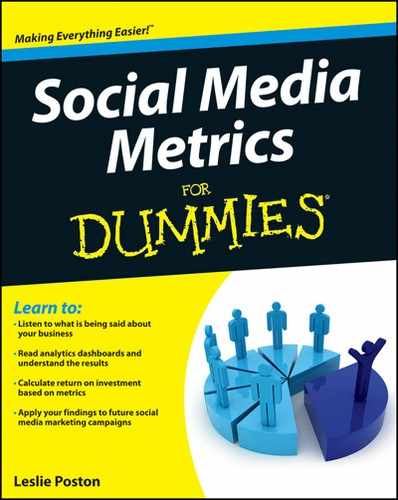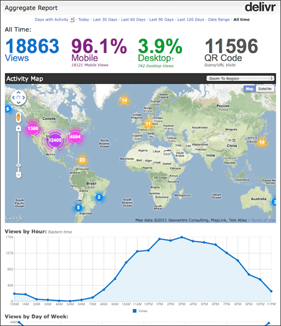Capturing Data with a Wide Net
The first step to being able to measure everything is to cast a wide net. This step involves several layers of action on your part, including excellent branding offline and online, comprehensive search engine optimization (SEO) and social media optimization (SMO) tactics, great web design that includes clear calls to action, a lean, focused business plan, and clear, measurable goals.
Becoming familiar with tools like keywords and with how people use the web and, more specifically, your website, will be invaluable to the process. Keeping up with changes in search engine tactics will help as well — Google has changed how it ranks sites in search results a number of times this year alone. Because search engines are constantly trying to improve results for people using them, you need to know the best practices of each one. If staying current on so many best practices sounds a bit daunting, start with the best-known ones like Google, Bing, and Yahoo!, and then expand from there.
Homing in on hyperlocal metrics
Hyperlocal means tracking social media and marketing metrics right at the point of sale, in your neighborhood, or a customer’s precise location. Hyperlocal takes metrics to the next level of accuracy by laser-focusing on where people are interacting with your brand.
The best way to get hyperlocal metrics is to add strong mobile and geolocation components to your marketing campaign and to have geolocation tools enabled on your landing pages. Encourage people to check in to your brick-and-mortar business and to interact with you on- and offline while they’re in the store. Best Buy does a great job of getting hyperlocal by using QR Codes and Facebook and foursquare deals and specials to encourage people to become more involved with its in-store shopping experience through interactive purchasing and on-site research.
One interesting thing for business is how many people choose to allow location-based tracking, seemingly without thoughts for safety or privacy, simply because it’s integrated into their favorite games and applications on their browser and their mobile devices.
If you’re not clear yet why getting hyperlocal with your measurement will benefit you, especially if you have a brick-and-mortar component to your brand, focus on samples of the questions hyperlocal metrics can answer for you:
![]() How many of my competitors within walking distance from me are getting more shopping traffic on a Saturday?
How many of my competitors within walking distance from me are getting more shopping traffic on a Saturday?
![]() How are folks engaging with the business next door right now, and how can I leverage that to bring them into my store?
How are folks engaging with the business next door right now, and how can I leverage that to bring them into my store?
![]() How many competing restaurants are located within ten blocks of me?
How many competing restaurants are located within ten blocks of me?
![]() How does peak shopping hours traffic compare block to block in my city?
How does peak shopping hours traffic compare block to block in my city?
![]() What is my market share for my type of business within a mile?
What is my market share for my type of business within a mile?
![]() What movies get the most check-ins at the theater on my block, and how does that help me target my merchandise to that demographic?
What movies get the most check-ins at the theater on my block, and how does that help me target my merchandise to that demographic?
These questions are just a few that location-based data can help you answer.
Hyperlocal isn’t restricted to brick-and-mortar stores, either. You can apply the techniques and concepts to online news-paid content sites and other intangible services and information outlets.
One business that is seeing results from a combination of hyperlocal marketing data and putting more control in the hands of store-level managers is Supervalu, a grocery store. Supervalu is empowering its managers with a hyperlocal demographic data dashboard that gives the managers information about the demographic makeup of their store’s neighborhood. Then Supervalu gives the managers full control of 50 percent or more of their store’s end caps (those displays on the ends of aisles and in the middle of walking paths inside a store). The managers are then able to combine the data with their creativity and experience to increase sales at a very local level.
Gathering global metrics
Hyperlocal metrics are important (see preceding section), but global metrics are equally important. Your brand has to be able to step back and view the big picture — to see its impact from a wider worldview. Having a global data set will help you make the fast, sweeping decisions you need to make in business.
What’s the difference between local and global measurement? You can fine-tune local (or hyperlocal, if you get very detailed with your data) measurement right down to the city block a person is on, the store she’s standing in, and the purchase she just paid for with her mobile device. You can discover whether that person is male or female and her income level and shopping habits, all within a block-by-block framework, if you want to get that detailed with your data subset.
Global measurement is broader in scope and looks at the patterns and habits of whole regions, areas, and countries. You can get similar drill-down demographic data like gender, age ratio, and online shopping habits, among other things, but global metrics are designed to give you a broader look at a whole data pile that includes broader matching on all data sets.
Global metrics will always be useful. For example, knowing that Twitter is “big in Brazil” is a metric that can help plan using the social tool behind a large campaign that will reach across countries. However, the trends are firmly moving toward hyperlocal and mobile for useful metrics that you can apply to economic growth and recovery.


 Do your due diligence before launching a campaign. Know who and where your audience is, how to measure your results, and how you’re offering them value in the process. The trade-off of an easy flow of data for your marketing use is the customer’s time, information, and attention. Give them value in exchange if you want to be a beloved brand.
Do your due diligence before launching a campaign. Know who and where your audience is, how to measure your results, and how you’re offering them value in the process. The trade-off of an easy flow of data for your marketing use is the customer’s time, information, and attention. Give them value in exchange if you want to be a beloved brand.
 Data is power, and hyperlocal data puts the power at street level for you to grab. Offer your customers and potential customers value in exchange for their location and habits data, such as paying with their phone or receiving a special or tip, and you’ll find that people will willingly share with you for that value.
Data is power, and hyperlocal data puts the power at street level for you to grab. Offer your customers and potential customers value in exchange for their location and habits data, such as paying with their phone or receiving a special or tip, and you’ll find that people will willingly share with you for that value.